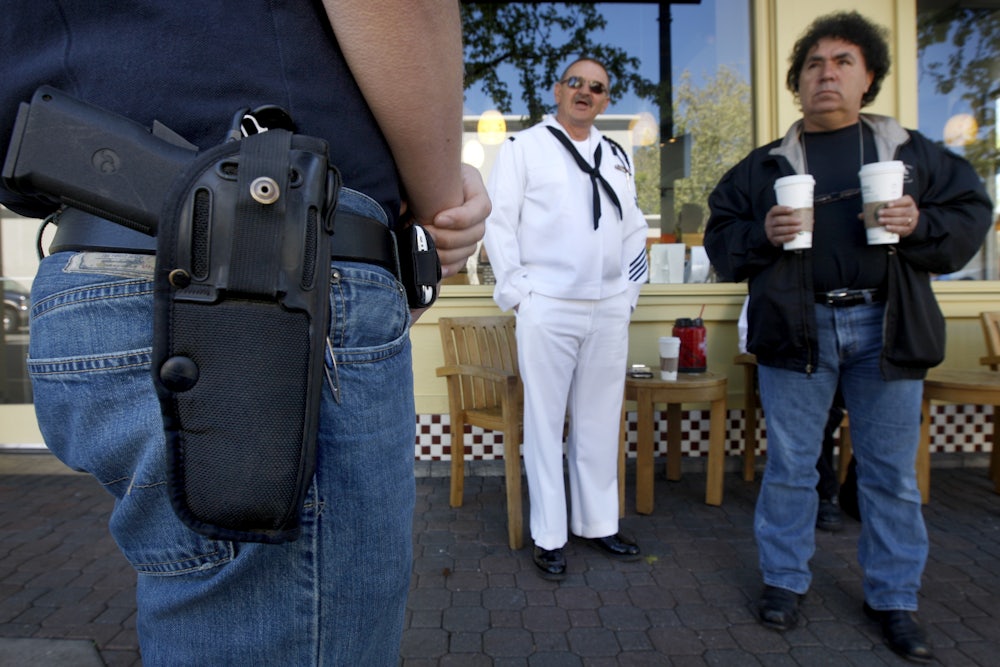The Supreme Court announced on Friday that it would review a Hawaii law that forbids gun owners from bringing firearms on private property without the property owner’s explicit permission. If the law falls, the court could make it significantly harder for states and cities to keep guns out of everyday life.
Wolford v. Lopez traces its origins to the Supreme Court’s recent decisions that rewrote the nation’s gun-related jurisprudence. The court’s conservative majority first recognized an individual right to bear arms in the Second Amendment in the 2008 case District of Columbia v. Heller and then applied it to the states in McDonald v. Chicago in 2010. After that, the high court did not take up another Second Amendment case for 10 years, despite many opportunities to do so.
Gun rights advocates who hoped that Heller and McDonald would lead to a sea change in the nation’s gun laws were quickly disappointed. Lower courts throughout the country left many existing gun regulations intact, citing broad language in Justice Antonin Scalia’s majority opinion in Heller that signaled the court’s desire to largely preserve the status quo.
“Although we do not undertake an exhaustive historical analysis today of the full scope of the Second Amendment,” Scalia wrote, “nothing in our opinion should be taken to cast doubt on longstanding prohibitions on the possession of firearms by felons and the mentally ill, or laws forbidding the carrying of firearms in sensitive places such as schools and government buildings, or laws imposing conditions and qualifications on the commercial sale of arms.”
The lower courts’ general refusal to expand the Second Amendment’s scope—and the Supreme Court’s decade-long refusal to intervene—led Justice Clarence Thomas to complain in dissenting opinions that the court had reduced the Second Amendment to a “second-class right.” So too it might have remained had the court not undergone a major rightward lurch during President Donald Trump’s first term.
In 2022, the Supreme Court heard a challenge to New York’s restrictive concealed-carry law in New York State Pistol and Rifle Association v. Bruen. (The court originally planned to hear the case in 2020 but could not do so for procedural reasons.) The court struck down the law in a 6–3 decision, ruling that the right to bear arms extended beyond the home and into public places. It also introduced a new history-and-tradition test for the lower courts to use when reviewing the constitutionality of gun-related restrictions.
“When the Second Amendment’s plain text covers an individual’s conduct, the Constitution presumptively protects that conduct,” Thomas wrote. “The government must then justify its regulation by demonstrating that it is consistent with the nation’s historical tradition of firearm regulation. Only then may a court conclude that the individual’s conduct falls outside the Second Amendment’s unqualified command.”
Thomas’s test was originalism in its purest form. It was also something of a disaster. Just as Heller had suggested that most existing gun laws were still constitutional, Bruen suggested that most of them were now unconstitutional—unless, of course, they could meet the nebulous test of finding an “analogue” to a “historical tradition.” Judges across the ideological spectrum struggled in good faith to come up with a consistent way to apply Bruen to existing laws.
It did not take long for the court to reverse its mistake. Last year, the justices took up United States v. Rahimi to revisit the scope of the test. At issue in Rahimi was whether a federal law that disarmed people accused of domestic violence could pass constitutional muster. Under a strict reading of Bruen, the answer was clearly no. There were no historical analogues from the founding era because eighteenth and nineteenth century America did not generally recognize the concept of domestic violence in the law.
Not to worry, Chief Justice John Roberts wrote in his majority opinion. Courts need not find an exact analogue to uphold a gun restriction. It must only “comport with the principles underlying the Second Amendment,” and supporting examples did not have to be a “dead ringer” or a “historical twin.” The 8–1 ruling amounted to a sharp rebuke of Thomas’s majority ruling in Bruen, which he alone defended in a lengthy dissent.
Among the states that rewrote their gun laws to reflect the post-Bruen landscape is Hawaii. Generally speaking, a person’s ability to lawfully carry a gun depends on where they are. Heller affirmed that it is lawful to bear arms inside one’s own home. Bruen expanded the Second Amendment’s scope to public spaces, although the exact contours have yet to be fully defined. (Courts have routinely upheld restrictions on carrying a gun in places like courthouses, schools, and hospitals, for example.)
At issue in Wolford is when it is lawful to carry a gun on private property. Obviously, there is no specific constitutional issue with carrying a gun on private property with the owner’s permission. Nor is there a Second Amendment violation when private property owners deny access to gun owners. For more ambiguous cases, Hawaii’s default property rule holds that carrying a gun on private property is unlawful unless the owner provides “express oral or written authorization” in advance or using “clear and conspicuous signage.”
Challenging the 2023 law are a group of individual gun owners and the Hawaii Firearms Coalition. They argued that, on a practical level, most businesses and private property owners won’t grant blanket permission or post signs to that effect. “The net result is that Hawaiians, including [the plaintiffs], no longer may carry firearms for lawful self-defense in tens of thousands of private property locations in Hawaii,” they told the court in their petition for review. “That result is impossible to square with the ‘general right’ to carry in public Bruen recognized.”
That argument did not persuade the Ninth Circuit Court of Appeals, which ruled in Hawaii’s favor by citing a few historical analogues, such as some 1720s laws in New Jersey and Pennsylvania that prohibited bringing a gun on plantations without the “license or permission” of the owner. Even broader laws—a 1771 New Jersey law and a 1865 Louisiana law that applied on all publicly accessible private property—served as evidence of a commonly held principle, as Bruen and Rahimi required.
The Trump administration also urged the court to take up the case and overturn the Ninth Circuit’s decision, which it described as “nullifying” Bruen. “Because most property owners do not post signs either allowing or forbidding guns, Hawaii’s default rule functions as a near-complete ban on public carry,” they claimed. “A person carrying a handgun for self-defense commits a crime by entering a mall, a gas station, a convenience store, a supermarket, a restaurant, a coffee shop, or even a parking lot.”
The state of Hawaii vigorously defended the lower court’s ruling and the default property rule in general. The revised law, it argued, “represents a permissible effort to vindicate the rights of Hawaii’s citizens to exclude armed individuals from their private property.” Default property rules are not unknown to the law, it observed, pointing to a 1951 Supreme Court ruling in favor of a municipal law that forbade “door-to-door solicitation” unless the owner gave express consent, even though such a law might appear to violate the First Amendment.
Hawaii also pointedly noted that, when it comes to history-and-tradition tests, the state has a unique tradition of its own as a former sovereign country. The plaintiffs claimed there was a historical tradition of implied permission in American history. “That may be true in other states, but in Hawaii, open carry has never been the default,” the state told the court. “Hawaii has limited the carrying of weapons in public spaces since at least 1852—decades before the U.S. Constitution was extended to Hawaii.” (The islands were annexed by the United States in 1898.)
It is unclear how the justices will receive that particular argument. The conservative justices have already struggled to define exactly which parts of American history count for the history-and-tradition test, having punted on its scope in Bruen and largely avoided it in Rahimi. The Supreme Court even refused to take up a question presented by the plaintiffs in Wolford on whether post-Reconstruction laws can be cited as historical analogues. That evasion suggests that the justices aren’t much closer to a consensus than they were in 2022.
Either way, the court’s overall approach to Second Amendment cases since 2020 is not reassuring for gun-control supporters. Only five other states have a default property rule similar to Hawaii’s for carrying guns, so the national legal landscape would not significantly shift. At the same time, Wolford is an opportunity for the court to declare how extensively guns can be present and visible in everyday American life. Oral arguments will likely be held this spring, with a decision to come by the end of the court’s term in June.






